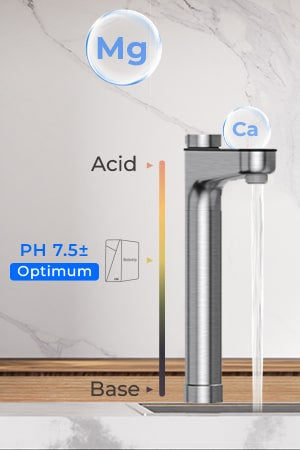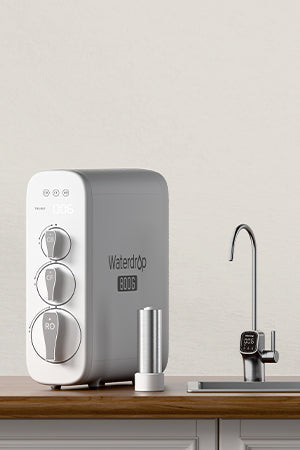The sentence "You will not miss the water until the well runs dry",
is correct. Tap water in the United States has been the subject of countless safety accidents in recent years
These events had a direct impact on the lives of the locals.
The German Environmental Protection Agency wants to reduce the lead content
from 15 parts per billion to 10 parts per billion, and the Biden administration has a
A $30 billion plan has been proposed to remove nine million lead pipes in ten years to
This measure is a response to past neglect and
a response to the renewal of lead pipe stocks. This also shows the importance that the
US government's focus on water treatment systems and water pollution solutions.
According to a report by the Environmental Working Group (EWG), tap water that
drunk by 218 million people, contains to varying degrees the toxic element hexavalent
Chromium contaminated. It is obvious how many different pollutants our drinking water contains.
Concern about the safety and quality of tap water is growing. With regard to
the quality of the water we drink every day, we can't wait to take action. Where
Where does tap water come from? What pollutants are produced?
Is tap water drinkable?
We need to identify the source of the water before we can find the solution for the
fully understand water pollution.
Surface and groundwater are the main sources of tap water in the
United States. Water must be obtained from sources such as ponds, reservoirs, springs, rivers, lakes, streams and wells
flow to our taps. The filters of the water treatment plant collect the water, supply it with
Water pumps and then distribute it via pipes to all exits of our house.
But there are many pollutants in this process. Concerns include
microbial pollutants, aging pipelines and infrastructure leading to heavy metal contamination
chlorine residues in water treatment and pollution of industrial and agricultural
wastewater that enters the water sources.
As we have seen, the drinking water supply with this system alone is
difficult. It may not always be safe to drink, even with the best tap water in the DE.
What are the most common pollutants in tap water?
The main pollutants in our daily drinking water can be divided into four categories
inorganic substances, including heavy metals such as lead and mercury; microorganisms,
including bacteria, viruses and parasites; radioactive substances, including uranium and radium; chlorine, a
Byproduct of water treatment. Organic pollutants also include industrial and
agricultural pollution (such as pesticides and herbicides) and leachate from household products such as
PFAS .
However, the intake of these substances or the environment can cause some very specific
have an impact on our bodies.
Chlorine is often used to purify municipal water supplies.
small amount of chlorinated water will not really harm you, but too much chlorinated water or its
Byproducts can be harmful to your health. Prolonged exposure to byproducts can
increase the risk of cancer and lead to skin and vision allergies.
Lead
Old pipeline networks and systems, especially those that are subject to pipe replacement or
an old infrastructure project contain lead. While a slight increase in lead content
in the body can be normal, more lead in water can lead to learning difficulties, developmental disorders
and even hearing loss. They can also cause abdominal pain, constipation and fatigue.
PFAS
Common locations for PFAS in water are near chemical plants and
industrially contaminated sites. It is difficult to decompose and is used in fire foams and antifouling paints
and other water-repellent and antifouling materials. It can be an endocrine disruptor,
which is related to the immune system, thyroid, cholesterol and other problems. It makes some
types of cancer. Long-term consumption is associated with health problems in pregnant women and their babies
tied together.
Natural water sources usually contain fluoride, but in many places
Fluoride is also added to water to prevent tooth decay. Fluoride is good for your teeth when taken in small
amounts; too much can lead to fluorosis or bone problems. Therefore, look for
Household water filter systems are looking for solutions on how to remove fluoride from water to produce fluoride-free
to obtain water.
Additional
In addition to the main pollutants mentioned above, there are a number of other pollutants. For example,
Untreated animal excrement can contain bacteria and viruses if it enters drinking water sources.
These can cause nausea, diarrhea and other gastrointestinal problems as well as more serious illnesses
cause.
How can we find out what is polluting our community's water?
We locals have many opportunities to monitor water quality in real time
Although these methods are less effective than those used by professional assessment departments and organizations,
have certain errors, they still have a certain reference value.
If you are a pragmatist. You can then
Buy household water quality test paper online or in a physical store. The color of the
Test paper changes when immersed in tap water and according to the instructions there is a wide
Range of instructions for the degree and type of pollution in the water.
In contrast, there are a variety of test kits on the market for
Household water, which can be used to test for common pollutants such as lead, chlorine and hardness.(
calcium and
magnesium ion). These tests will give more accurate results than standard test strips. If you spend money
you can of course collect water samples and send them to a licensed laboratory for more thorough
to analyze.
By visiting the websites of your canton and the local health or
Environmental protection authorities can provide you with the information you need more quickly and easily. There you will find
Water quality reports and any health advisories applicable to your area.
If you are interested, you can also refer to a page on our
brand website where you can search for pollutants in your area by zip code. We test
this function now, but soon you can open our interface and use the query function to
always know what pollutants are present in your community’s water supply system. An important
Building block to achieve transparent information on drinking water quality.
The ideal solution-purchase of a reverse osmosis system to remove pollutants from the water
Another name for reverse osmosis systems is the water purifier. Materials such as
PP cotton, activated carbon RO membrane and others make up the majority of the filter cartridge.
Reverse osmosis filtered water is drinking water, ie it is pure H2O with a filtration accuracy of
0.00001 μm.
Reverse osmosis is an effective method to remove bacteria, viruses, scale,
To remove heavy metal ions, odors, sludge, colloids, suspensions and humus from the water. The TDS in
filtered water from the RO water purifier is usually low. Both cooking and drinking
directly from the RO filter are options for this water. The kettle or electric heater is
no longer scale, which is the most obvious feature.
The long-term absorption of RO filter cartridge pure water has no negative
Effects on the body because it is membrane-filtered water that is free of pollutants.
Wassertropfen G3P800 reverse osmosis system
PFAS, fluorides, heavy metals, salts and large particles are just some of the
Pollutants that the Waterdrop G3P800 removes through its nine-stage, SGS-certified filtration process
effectively removed. It has a powerful filter unit that can filter up to 800 gallons of water per day
produced with a purity-to-drain ratio of 3:1, minimizing wastewater.
By eliminating up to 99.9% of bacteria, the
UV sterilization technology improves filtration efficiency. It also includes a smart faucet that
continuous measurement of TDS and water quality in the water for easy operation.
The system is certified for lead-free and TDS emission reduction
NSF/ANSI
58 and
NSF 372 . Let it
Purify your water every day; this is a smart move.




































































